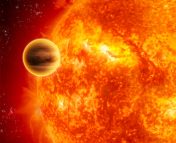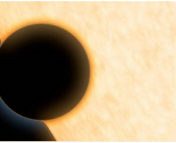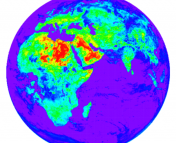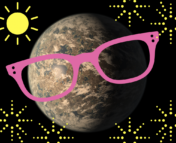
by: Sahil Hegde and Mark Popinchalk
Dr. Phil Plait, an astronomer-turned science communicator, has just published his fourth book, titled Under Alien Skies. In it, Plait excitedly takes us on a tour of different locations in the solar system, galaxy, and universe, to see what the sky might look like there. As he does so, it’s like watching someone fall in love with science all over again as he deftly walks the reader through how things would be different; what are the atmospheric effects, what stars could you see, and what would you be able to stand on (if anything!). Each chapter is framed with a vignette of an interstellar traveler (us) experiencing a visit to some extraterrestrial object. Having piqued our curiosity, Plait then proceeds to walk through some of the basic science associated with that place, breaking down why we experienced it as we did!
A lifetime of stargazing
Phil Plait’s writing is saturated with his excitement about astronomy. It’s quite frankly dripping off the page, an infectious energy that makes you want to put down the book and look up at the sky. There are 10 locations in the book, and the joy he must have felt learning, imagining, even dreaming about what the experience of a human looking up would be radiates off the page. Plait takes (what feels to us as) a fresh approach to tackling the problem of how to describe the skies. Rather than inviting us to step outside, look up, and envision a seemingly fantastical concept of our universe, he describes how we might feel looking up at the unfamiliar “alien skies.” However, we’re not alone on this interstellar adventure—Plait serves as our tour guide, mapping out the stars and skies around us.
“When I was a kid, I had a telescope I would haul out on every clear night. It wasn’t small: a 6-foot tube with a 10-inch mirror at one end, plus a tripod equipped with massive counterweight. The whole kit weighed well over 100 pounds and looked like an overly fancy water heater. But whenever I could, I would lug it from the living room out the front door and down the driveway to do what I loved best: stand under the night sky and visit my favorite objects tacked among the stars.”
We remember reading popular science books like this when we were in middle and high school and the excitement we felt imagining the worlds they described, so returning to this genre now as graduate students studying astronomy was definitely a unique experience! It’s often easy to get bogged down in the minutiae of day-to-day research, so it was especially refreshing to take a step back and marvel at these alien skies as we did all those years ago. As lifelong sci-fi fans, the chapter-ly vignettes were the perfect fodder to satiate our excitement for both science and fiction and kept us hooked throughout.
Wide Field of Views
Take for example the early chapters, where he starts off “close to home”, on the Moon, Mars and an asteroid. The first order changes that spring to our minds would be the atmosphere being different, or the inclusion of Earth in the sky. But Plait’s description grounds the reader, creating an image of the night sky by building from the ground up. We’ve never enjoyed a description of lunar regolith sticking to suits, dust storms streaking across the horizon, or asteroid composition creating uneven footing as much, and it took us a while to realize why. When we reflect on what was memorable about night sky viewings in my life, it is those environmental details that stick. It must have been double the work to create these descriptions around your celestial vantage point, but the effect is ten times the immersion.
In some of the later stops on our interstellar journey, Plait takes us beyond our solar system as we visit exoplanets in some truly fantastical environments. On one such trip, we enjoy a day under “Tatooine’s Sky” and consider living on a planet with two suns. Grounding us with the science of how we know that such binary stars and planets even exist, he then steps into the realm of imagination as he constructs an incredible fantasy of the experience. Plait gives us a tour of the remarkable skies we’d experience—for example, eclipses would be as regular an occurrence as sunrise (or “sunsrise” for this planet, as he calls it) and sunsset. The real immersion for us, however, came when he took this one step further and envisioned how life on such a planet might adjust to the wild swings in temperature and climate that might result from circumbinary orbit.
“It’s also possible that while some globular clusters orbiting the Milky Way really are globulars, they were stolen from those other galaxies it ate. That seems a little rude, to be honest—like walking by someone eating in a restaurant and stealing food off their plate. Galaxies, apparently, sometimes lack decorum.”
Once we’ve gotten comfortable with the two-sun sky on this binary planet, Plait challenges us to imagine hanging out on a planet orbiting a star in a globular cluster (as he calls it, “a planet with a million suns”). Here it is truly the night skies that will change the most staggeringly from our familiar vantage point on Earth. With millions of stars to gaze upon, this is the perfect opportunity to imagine what it might be like to watch stars at various stages of their lives with our bare eyes. However, Plait understands that this sort of journey isn’t all just fun and games: he makes sure to give us a dose of realism as we think about whether such a planet could even exist—and if it did, what challenges it might experience.
Keep Looking Up
All together, this book really taps into our (and Plait’s) childlike excitement for imagining life beyond our solar system. Grounded in the scientific principles that make us—even now as adults—maintain a belief that such life could exist, Plait’s interstellar adventure is a thrill to experience and luckily he’s taken the time to invite us along.
Under Alien Skies is now available for pre-order, and will be released on April 18th, 2023, available wherever books are sold.
Featured image credit: Phil Plait / WW Norton Publishing
Thanks to Phil Plait, Erin Lovett, and WW Norton Publishing for providing advance copies of the book for this review!




